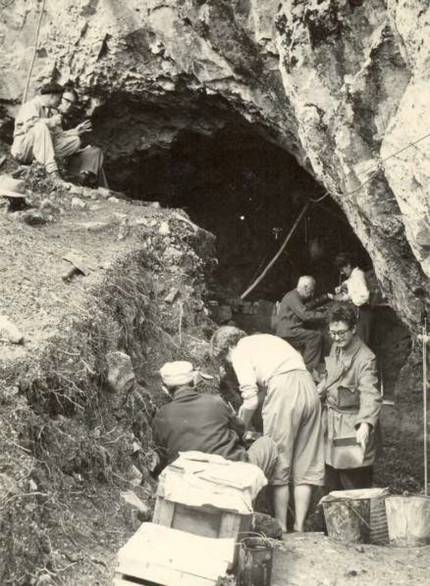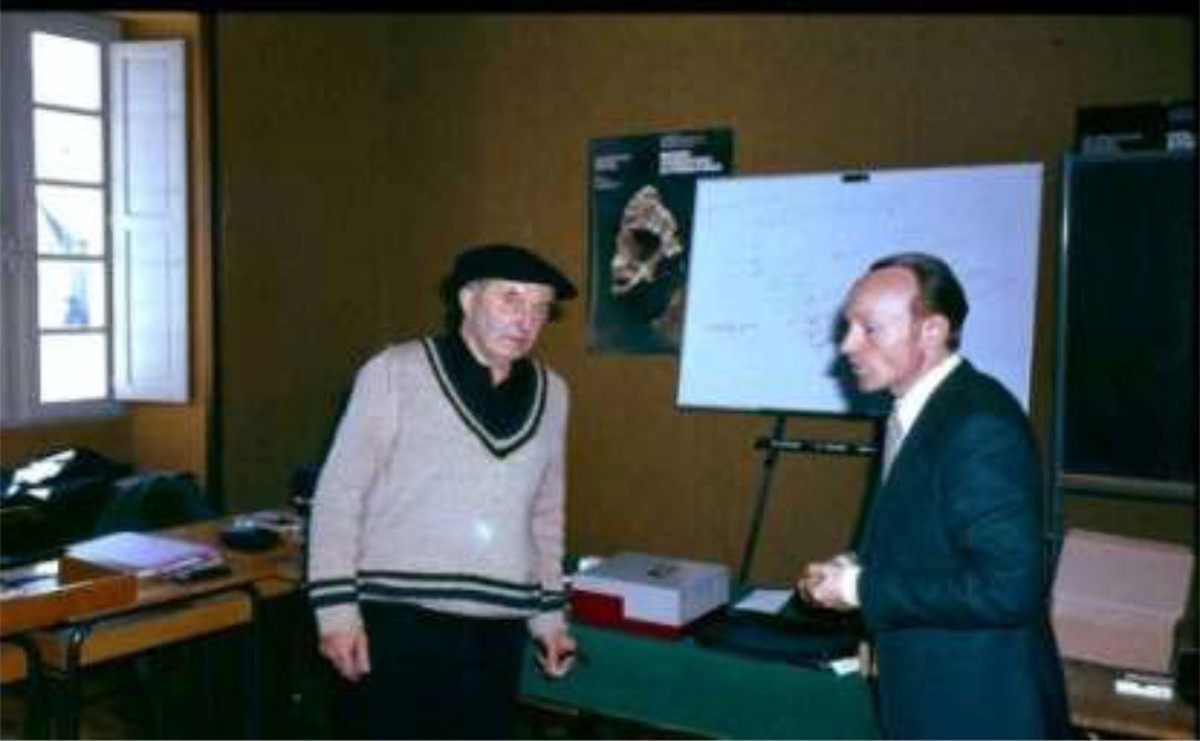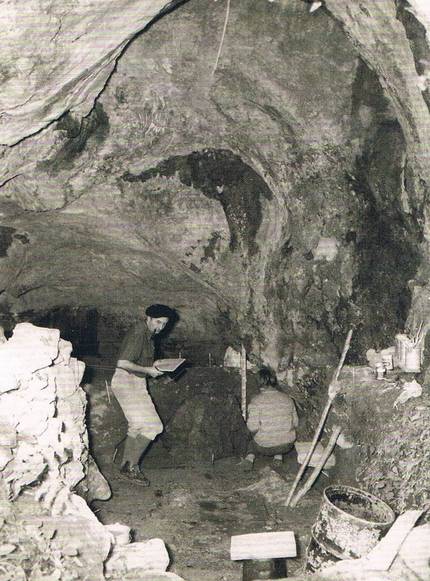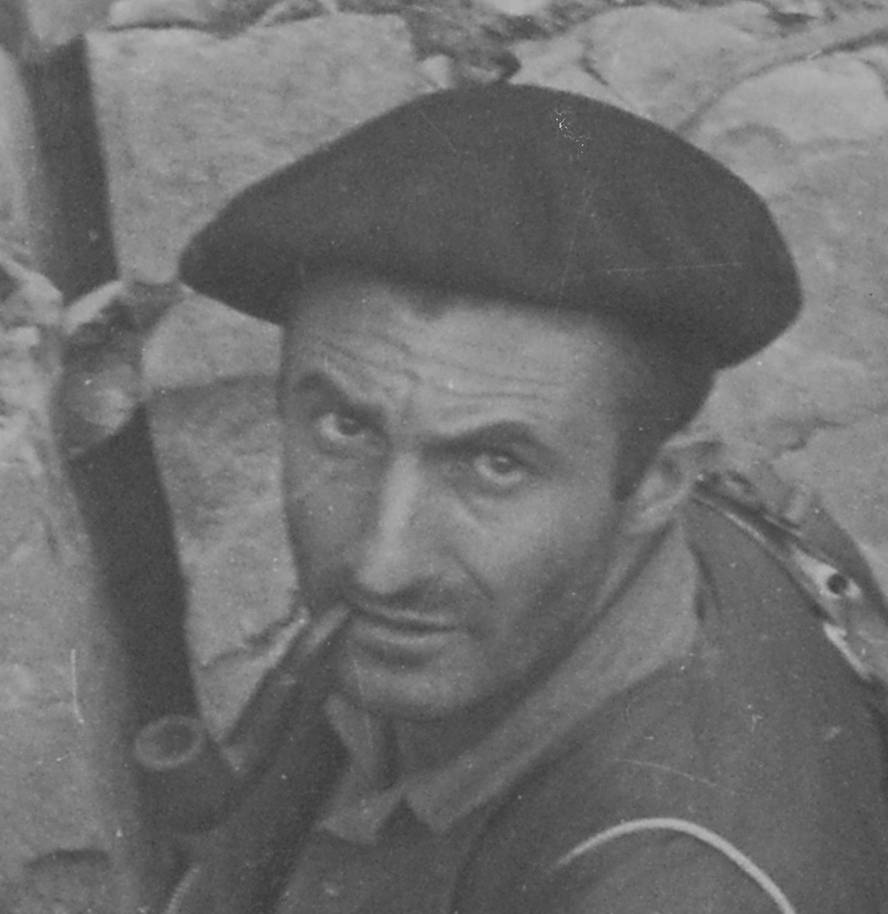Georges Laplace: dialectics and freedom
Archeologist Georges Laplace (Paue, 1918-2004) independently researched to become one of the largest paleolithic experts in Europe. In the 1950s he deeply reformed the archaeological methodology and developed the excavation system (with Cartesian coordinates) and the method of analysis of the archaeological remains (structural analytical typology), both currently in force.
First excavations and Cartesian method
He was born in an atheist and left-wing family and, as a young man, he dedicated himself to lay scout groups; he considered himself bearnoteworthy, Ibero-Aquitaine, Agot and Euskaldun (COLMONT, 2019). In 1938 he took the title of teacher and was professor at Eskiula. II. He fought against the Nazis during the World War and exercised resistance with military training and support for the maquis. From the 1940s he had a great relationship with Basque researchers: He was a member of Eusko Jakintza, the Ikuska Institute and the Aranzadi Science Society, and maintained a close relationship with Joxe Migel Barandiaran, with a different mentality [1].

In 1947 he participated in the excavations of Montmaurin with Louis Méroc, professor of the University of Tolosa and founder of the Société Meridionale de Spéléologie et de Préhistoire (SMSP). That same year, he found a deposit in the shelter called Olha II (Cambo) and collaborated with Barandiarán in the Western Pyrenees section (SMSPPO) of the SMSP. In 1948 he developed a method of Cartesian coordinates to geographically locate remains in the cave of Tute de Carrelore (Ossau), improving the system of Méroc, publishing his first work (LAPLACE-JAURETCHE, 1949; in his first works, Marie-Henriette Jauretxe uses the last name of his first wife). In 1949 he began the works of the Arenal de Olha (Cambo) and lasted until 1961.
The archaeological trajectory of Laplace began in the speleological groups, to the point that the paleolithic was an inexorable research topic related to caves. In the spring of 1950, in the Arenal de Etxeberri (Gamere-Zihiga) new galleries were found to which the speleologists of Maule, Oloroe and Pau, among them Laplace themselves, discovering their rock art. It was also related to the members of the Grupo de Espeleología de la Piedra San Martín: In 1950 they met in Etxeberri and in 1952 Laplace actively participated in rescuing an accident suffered by Marcel Loubens. But Laplace soon deepened in the archaeological field by moving away from the activity of the speleologists.
Rare scientific route of Laplace
Laplace was characterized by denying the argument of authority and continually reviewing theories: "Undoubtedly, the theories that express our set of scientific ideas are essential to express science. (...) But these theories and ideas are not at all an immutable truth, so we must always be willing to leave them, to change, as they do not explain reality" (LAPLACE, 1966). On the other hand, he remained away from the academic hierarchy and the metropolis, concentrating most of his career in the area of Bearno.
Laplace changed over the years his attitude towards amateur/professional concepts. He began his career in amateur scientific societies: Around 1947 in SMSPPO and in 1948 in Société Préhistorique Français (SPF). But in 1949 he claimed the need to improve the procedures of archaeologists, opposing amateurism and defending professionalism (LAPLACE-JAURETCHE, 1949b). Prosa, in 1950, entered as an assistant researcher at the Centre National de la Récherche Scientifique (CNRS) and applied for a master's degree, which in 1951 broke with most scientific societies. Not at all, but in 1953 he joined the Société des Arts de Pau, Lettres et Sciences, and promoted the meetings of the SPF members of the region. In 1961 he presented his doctoral thesis: He studied European prehistory from the point of view of the lithic industry, including that of many sites around Euskal Herria. In 1966, together with Alberto Broglio, he began to promote a research group based on analytical typology. By then, Laplace's attitude changed markedly to criticize the amateur procedures of some professional archaeologists [2].
In 1968 he carried out the first update of his analytical typology and rose to the category of Master of Research of CNRS. This allowed him to choose lines of research, seek money and direct projects, capacity he used to create his own research center. Ceded by the City Council of Arudio. In a house of the twentieth century founded the Centre of Palethnologie Stratigraphique Eruri, which would become a prestigious center of reference research. From 1969, annual meetings were organized on analytical typology and, from 1973, Dialecticff. Publication of the journal Cahiers de typologie analytique [3]. Although Laplace retired in 1983, he continued to organize these annual seminars and publish the magazine until 1989. The Arudic Research Center was exceptional: in front of the authoritarian organization of the archaeology of that time, it promoted teamwork and freedom of thought for itself (PLUTNIAK, 2017).
In 1969, Laplace also became a member of the Centre de Paléontologie Stratigraphique de Lyon, and collaborated until 1974, when he took charge of his own march: "You must know that there are deadlines, rules, printed and that you have not complied with anything, and that this is not acceptable behavior by an adult researcher. (...) This demonstrates, once again, that it does not meet the requirements of an official research structure" [4]. In his response, Laplace reaffirmed his support for his freedom: "«An isolated researcher, I?» No; I am an autonomous researcher, an independent researcher, a free researcher, like my research, who ignores the owners and their clientelism, who works calmly with his colleagues, without the aim of ascending. The Center of Stratigraphic Paleontology has honored me when it has opened the doors to me, just as the behavior of a free man has honored the Center. Live fast!" [5].

In 1971 he published the second update of his Analytical Typology and began teaching at the newly created Université de Pau et des Pays de l'Adour. In 1974 he directed the I International Prehistory Colloquium in Morella (Castellón), a meeting that provoked a great shock in the late panorama of the paleolists of the Franco dictatorship. In 1978, when he became Research Director of the CNRS, Laplace's criticism became even more acute: "The research institutions are led by a heavy, dominant hierarchy, which is a reflection of the social hierarchy, heir to the religious hierarchy and medieval university institutions, (...) which generally denies and discourages novelty, unless it admits it in the hope of appropriating it. Are these the professionals you mention?" [6].
In 1983 Laplace became Director of Honorary Research at the CNRS and retires. However, in 1983, 1985 and 1986 he taught seminars at the University of the Basque Country in Vitoria-Gasteiz. In 1999 he was appointed Knight of the Honorific Legion by the French government in recognition of his vital career and died five years later.
Analytical and structural typology

In the works carried out in the paleolithic sites and based on dialectical materialism, Laplace developed a classification according to the hierarchical analysis of the characteristics of the instruments. In addition to those mentioned above, he studied in Euskal Herria more fields: Sasiziloaga and Gatzarria (Ozaze-Zühara), Harregi (Altzürükü), Üztarbe (Larraine), Otsozelaia / Haristoi eta Erberua (Arberua)...
Between 1953 and 1958, most of his research was conducted outside of France: He deepened the typology of lithic instruments of the sites of Algeria and Tunisia, finding a more friendly atmosphere among archaeologists than in the metropolis. In fact, the French archaeological community did not accept Laplace's proposal, largely because of its Marxist base. In 1956 he entered the École Français in Rome and began to analyze the similarities between the sites of North Africa and those of Italy. Laplace's method had a great success in Italy, on the one hand because Laplace had the opportunity to analyze the collections of reciprocal enemy archaeologists (impossible for an Italian) and, on the other, because the typology of Laplace covered the gap existing in Italy in this field. In those years he divorced Henriette Jauretxe to marry the archaeologist Delia Brusadina. Although he became the first archaeologist at the residence of École Française, in 1958 he returned to France, where he hardly found travel companions to develop his theories and worked alone in the following years.
In the 1960s, interest in the analytical typology of Laplace emerged among young researchers from different countries, from 1968 to France. His presence became more and more common in the academic world, without abandoning the field work: Between 1972-1977 he worked at the site of Olha II, in 1978 he led the research group of Erberua, and after his retirement, in 1984, he reviewed the low reliefs of the column of the Great Hall of Izturitz with Ignacio Barandiaran.
Over time, Laplace's Analytical and Structural Typology has made its own journey to surpass the author himself. It has been proven that this system can extend beyond the lytic materials and, after Laplace's death in 2004, it has been used to study various systems such as bone fingerprints, stratigraphy and exploitation of large vertebrates (ESTÉVEZ, 2015).
[1] “Laplace-Jauretxe and his wife came to them. He said the two have left the communist party, which are communists. They have come out of the party because the party comrades do not play well; because they have their opinion and their leaders as gods; and because the lie and evil of their beliefs are good. I told Laplace that we have five or forty miles of bear pound.” (BARANDIARAN, 2009).
[2] Criticism of Sonneville-Bordes. Letter to Henri Delporte, November 15, 1967.Laplace Fund, Musée National de Préhistoire, Les Eyzies–de–Tayac.
[3] In 2006, Laplace's followers released a special issue of Dialectiké as a posthumous tribute.
[4] Letter of Louis David to Laplace, March 15, 1974. Laplace Fund, Musée National de Préhistoire, Les Eyzies–de–Tayac.
[5] The last two words (sic) are in Basque in the French text of Laplace. Letter to Louis David, March 21, 1974. Laplace Fund, Musée National de Préhistoire, Les Eyzies–de–Tayac.
[6] Letter to Jean–Georges Rozoy, September 16, 1982.
Bibliography: Bibliography:
BARANDIARAN, José Miguel. 2009. Diario Personal. Volume II (1936-1953). Euskal Herria Continental. José Miguel de Barandiaran Foundation. Sara Collection 8. Ataun.
COLMONT, Gérard. http://colmont.wifeo.com/georges-laplace-sa-carriere.php Personal website of the archaeologist consulted on 9 October 2019.
ESTÉVEZ, Jordi. 2015 Analytical Archaeozoology. Another practical example derived from the work of Georges Laplace". Pp:48-60. In: CALVO, Aitor. SÁNCHEZ, Aitor. GARCÍA-ROJAS, Maite. ALONSO-EGUÍLUZ, Monica. (Eds.) 2015 Six decades of Analytical Typology. Proceedings in tribute to Georges Laplace. 13, 14 and 15 November 2012, Vitoria-Gasteiz. Research Group in Analytical Typology.
LAPLACE, Georges. 1966. "Recherches sur l’origine et I’évolution des complexes leptolithiques". These École Française de Rome. Mélanges d’Archeologie et d’Histoire, Suppléments 4(XII). 586 pp. Ed. De Boccard, Paris.
LAPLACE-JAURETCHE. Georges. 1949. "Gisement Azilien de la Tute de Carrelore, à Lurbe (B-P). Découvertes et Outillages". Société Méridionale de spéléologie et de Préhistoire, p:227-236.
LAPLACE-JAURETCHE, Georges. 1949b. "Prospections et fouilles". Eusko-Jakintza. Revue d’Études Basques 3:466–470.
PLUTNIAK, Sébastien. 2017 "The Professionalisation of Science – Claim and Refusal: Discipline Building and Ideals of Scientific Autonomy in the Growth of Prehistic Archaeology. The Case of Georges Laplace's Group of Typologie Analytique, 1950s–1990s." Organon 49:105-154.






